The Global Drug Survey 2015 findings
What did we learn from GDS2015?
An overview of our key findings
Dr Adam R Winstock, Founder Director GDS
Well first just how generous were people with their time?
We estimate that over the duration of the study (Nov-Dec 2014) over 100,000 people spent in excess of:
- 4 million minutes, or
- 67,000 hours, or
- 2800 days, or
- 400 weeks, or
- 7.5 years sharing their drug use experiences with us.
So a HUGE thanks to you all. GDS does not exist without you
I also want to acknowledge the unbelievable help that all our partners and the academic network and harm reduction groups around world provide with revising and translating the survey then working so closely with all our media partners. In particular, I want to acknowledge the vital role that Dr Jason Ferris, our chief biostats man, has provided with the analysis and production of reports. Thanks mate
Well working our way from the more common to less commonly used drugs these are some of interesting things we found out
Alcohol
Ireland’s reputation for heavy drinking is well deserved. Not only did Ireland have higher rates of drinkers at risk of dependence (AUDIT score of 20 or more), they report needing to drink more alcohol than almost any other country to get as drunk as they would want to be but they also had the highest rates of getting more drunk more often than they wanted to, thinking their doctor would tell them to drink less, attending A&E after drinking more often and perhaps thankfully the highest proportion of drinkers who want to drink less in the coming year
Global comparison of female AUDIT score >20 (scores of 20 or more are suggestive of dependence)
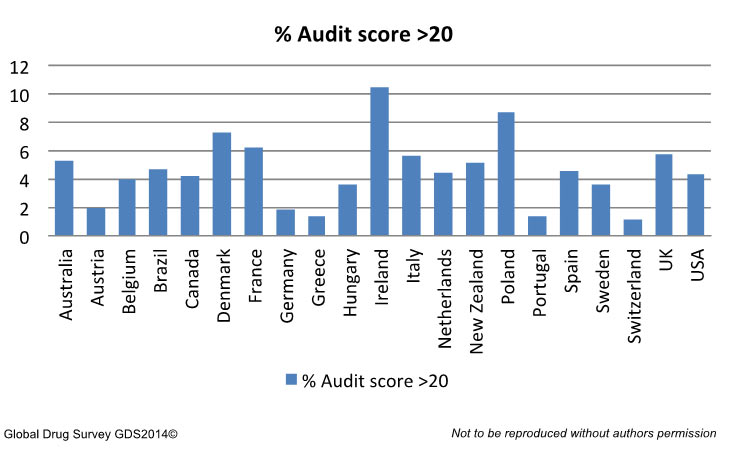
Global comparison of male AUDIT score >20 (scores of 20 or more are suggestive of dependence)
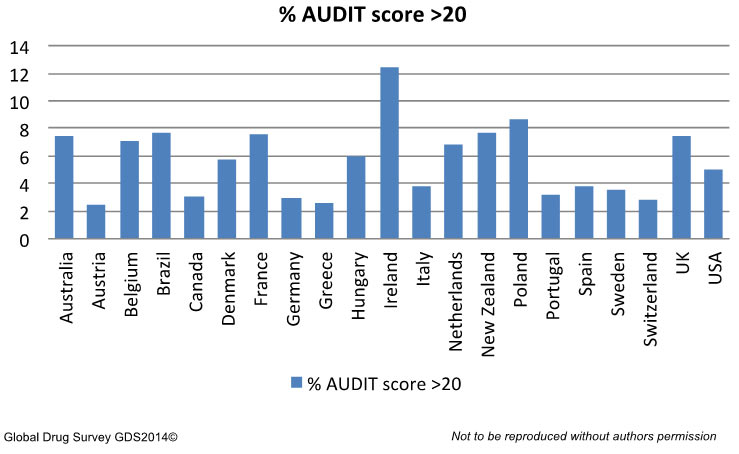
But the Irish stereotype aside (Australia, Netherlands, UK and NZ you can’t smile) I was struck by 2 things
There is NOT a fine line between getting as drunk as you would want get and being more drunk than you want. It’s about a 30% line (see the graphs below). Now not only is the mean amount of alcohol about 90gm for women and 120mg gm for men – about 5 times above what the WHO advise as the maximum amount to drink on a days
GLOBAL COMPARISON How much women around the world need to drink to get to different levels of intoxication (mean number of 10gm alcohol units)

GLOBAL COMPARISON How much men around the world need to drink to get to different levels of intoxication (in 10gm units)
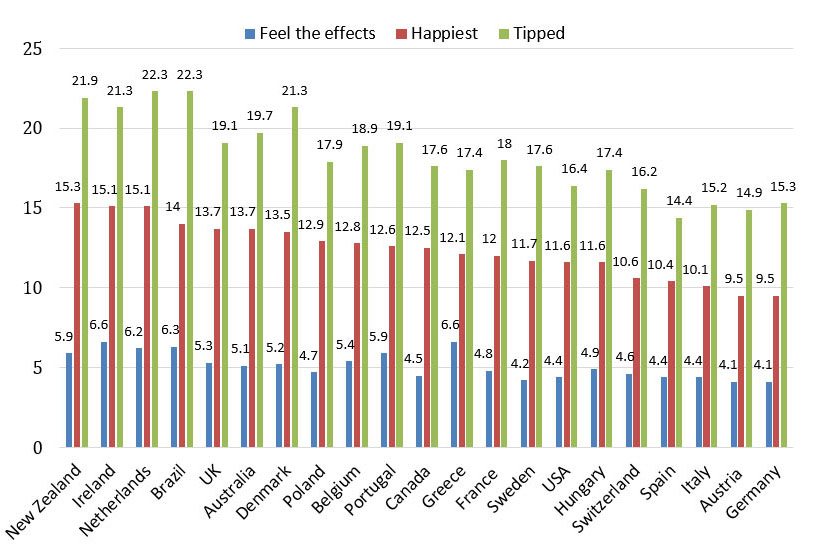
So with 20-25% of people on average saying they were getting more drunk more often than they wanted to (‘tipped’ at least monthly) here is my advice. When you get to the place you feel as intoxicated with alcohol as you want to, SLOW your drinking down. The tipping point for many people is just one or 2 drinks, so if you want to have a better, cheaper healthier night, just slow down and drink a little less. Want some advice go to www.drinksmeter.com or get it free on the app stores
The other thing I learned is how different things motivate different groups to change their drinking, with social embarrassment being a huge motivator for many especially the Germans, Swiss Austrians and the Aussies. If you want to see how much of an ARSE (stands for Alcohol Related Social Embarrassment score) you are when you drink try the GSS One Too Many test at www.onetoomany.co
Tobacco
For tobacco we learned that far to many cannabis smokers continue to mix their weed / resin with tobacco and that we should strive to be like Americans or the Kiwis. And for all the fears over e-cigarettes while many smokers have tried them the proportion who go on to become of daily users is very small, though last year prevalence in many countries is increasing. More e-ciggie companies for the tobacco companies to buy I guess

Cannabis
And while high potency herbal cannabis dominates the world market and carries the greatest risk of harms it seems other types can also land you in the emergency department as well.
Preparation of cannabis used in associated with 434 admission for emergency medical treatment in last 12 months (%)

Preparation of cannabis used in associated with 434 admission for emergency medical treatment in last 12 months (%)

Sadly the uptake of vapourisers by the cannabis using community is still in its infancy – lots of lungs to be saved from harm out there.
While high potency cannabis remains dominant we learned that butane hash oil (BHO) is starting to nudge its way into the cannabis using community with over 2500 people sharing their thoughts on this new form of cannabis. Faster, stronger and possibly with higher risks of swifter development of tolerance and withdrawal it’s too early to pass judgment. It does allow for other methods of use to be adopted however as shown below and this might be a good thing
Butane hash oil methods of use
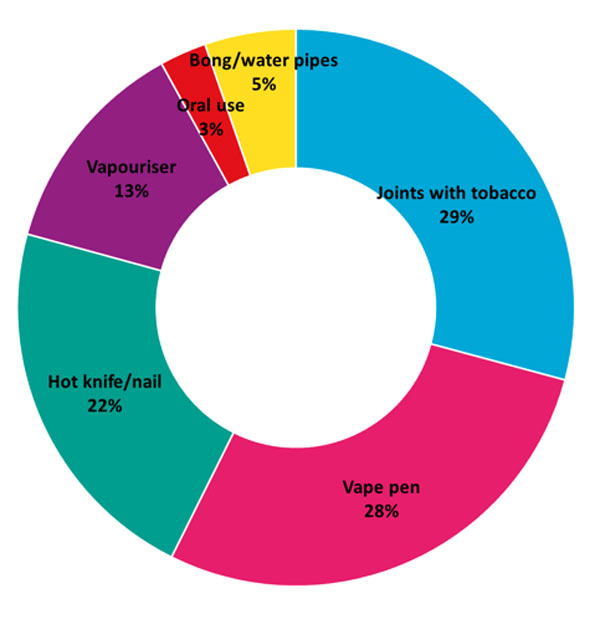
Hopefully more balanced BHO oils will appear and will encourage the use of vape pens so the typical trajectory of increased potency leading to increased problematic use and dependence can be exchanged for greater control and harm reduction. For this to be a reality the marijuana industry needs to get on board and provide an index to inform customers of risks and how to avoid them. And given one in 4 reported making BHO at home some occupational health and safety advice on choice of solvent, the need for good ventilation and to avoid unsightly explosions are probably needed. GDS will launch the world’s first ever safer drug use limits – starting with the cannabis guidelines on June 17th
Synthetic cannabis
But while BHO may be the new ‘natural kid on the block’, GDS’s work on synthetic cannabinoids continues to cause great concern. For the third year running these drugs were more to likely to leave people needing emergency medical treatment than any other group we explored this year- with 3.5% of last year users reporting having sought EMT in the last year a (30% increase from 2.5% last year). The risk increased to one in 8 users who reported using 100 or more times. This confirms our work published in March that the risk of seeking EMT was 30 times higher with SC products than high potency herbal cannabis (skunk, hydro). Our findings also highlighted the risk of dependence on these drugs with over 60% of those using 50 or more times reporting withdrawal symptoms on cessation. While herbal preparations remain the most common we also saw the appearance of crystal, resin and liquid forms
Why?
GDS remains confused as to why there remains a market for such an unsafe and less pleasant drug than the natural alternative. Our findings on the motivations among users of novel psychoactive substances (NPS) however suggests that price might be a key driver, with the average gram of synthetic cannabis (SC) costing €8 vs. €12 for weed, with most people getting 10 joints from a gram of SC vs. 3 from a gram of natural. Among some groups where access to natural cannabis is difficult there may be a greater attraction – such as prisons (where I work part time) and where people wish to avoid detection in drug screens. Think your train drivers, miners and truckers! Profits margins are huge, export is easy and regulation unenforceable. Perhaps cannabis dealers might like to lower the price of their produce, offer something other than high THC weed and governments consider if their regulation efforts on cannabis like products might be focused elsewhere? Maybe even offer some safe using limit guidelines for cannabis now it’s legal in some places. Oh hang on GDS is already doing that and releasing them in mid June!
Other novel psychoactive drugs (NPS)
Synthetic cannabinoids whilst the most numerous in terms of new notifications and market share are not the only class of NPS being marketed and used out there. And while GDS wont jump in the media scare mongering we did find that the rate seeking EMT on NPS generally was at least 3 x greater than for traditional illicit drugs (see graph below)
What % of people had sought emergency medical treatment following the use of drugs/alcohol in the last 12 months? (Global)
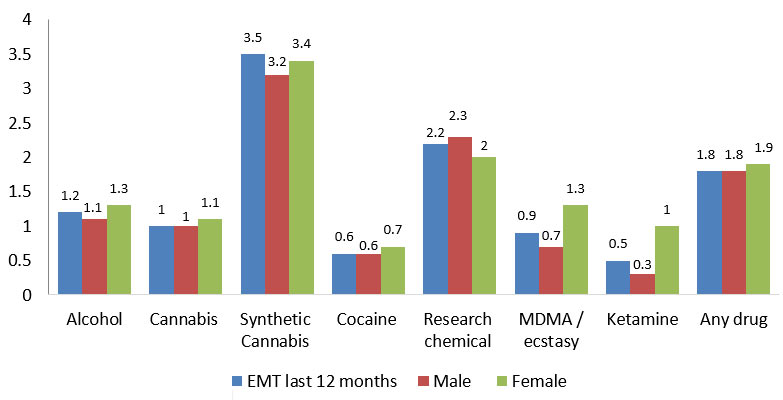
What % of people had sought emergency medical treatment following the use of drugs/alcohol in the last 12 months? (Global)

Unknown potency, limited honest product information (due to government regulation) and varied effect and risk profiles make shiny packets not a great way to get high. But as usual the factors leading to people seeking EMT on new drugs are pretty similar to the risks with old. The GDS poem for new drug takers is ‘If you take a drug you do not know our advice start low go slow and ask a mate to keep an eye on you cos you never know with something new’. If governments are going to ‘ban all new drugs that get you high’ then they need to better educate people who use traditional drugs to use them more safely. The GDS High-Way-Code does exactly this
Research chemicals – trends in use.
They’re on the decline. They may be more numerous but GDS has spotted a year decline in the UK and this has been noted elsewhere. Why? Because beyond being cheap, most of these new drugs offer less desirable and a more risky experience than the traditional drugs used across the world. And given drug use is a goal-orientated behavior with consumers making generally smart informed decisions around what they use, unless new drugs convey significant advantage in one or more domains (and price for some is very important) few will catch on
Four year GDS UK trends in recent internet drug purchases and NPS/RC/LH use
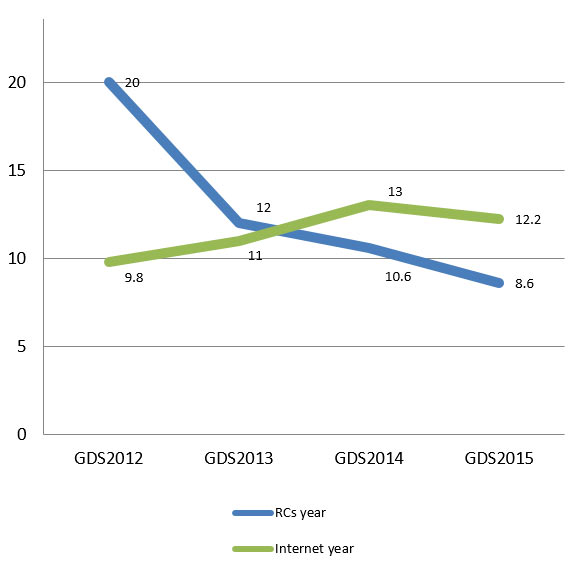
The UK still uses more than most but really with the re-emergence of better quality traditional drugs and the dark net I am unsure where these much hyped drugs are going in most countries
Research chemical/NPS use in the last 12 months
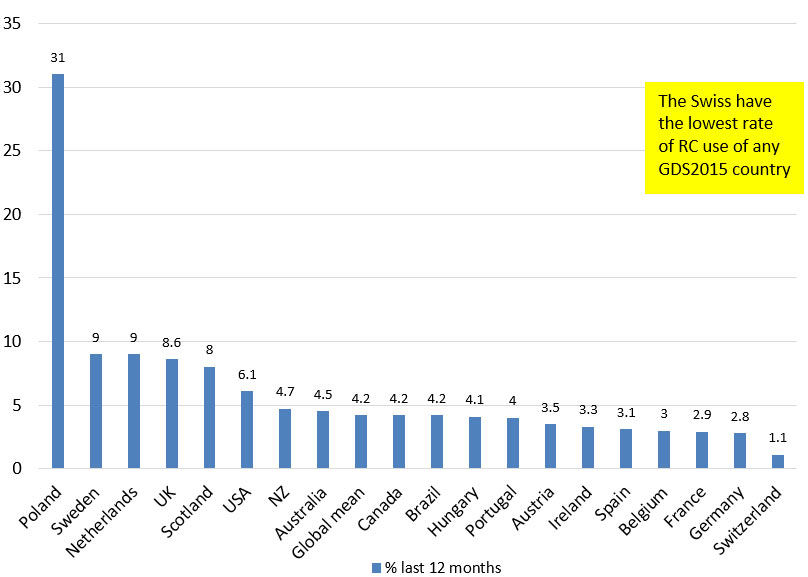
Cocaine
Cocaine remains the world most expensive drug per gram in the world (cannabis seeds are the most expensive though not strictly a drug of course). Most users (80%) use less than 10 times in the last 12 months in most countries at a mean price of 70 euros, he average of consumed dose of 1/2gm seems to be an example of harm reduction by price (minimum pricing in the UK). NZ and Australia remain the priciest place to buy cocaine in the world – why – because their border control is great and the size of the markets they offer to cartels is small. The presence of crystal meth also helps (or not, since it is a drug with whole loads more problems for users in most cases). Certainly cocaine markets have responded to the possibility of competition and low satisfaction with their product with a global two-tier market both at ounce/kilo level and street dealing gram levels. The graph below shows prices in EUROS. And before you think of going to Brazil for cocaine don’t, but you have to wait till they come out with their findings later this month to find out why
Average prices of cocaine in Euros
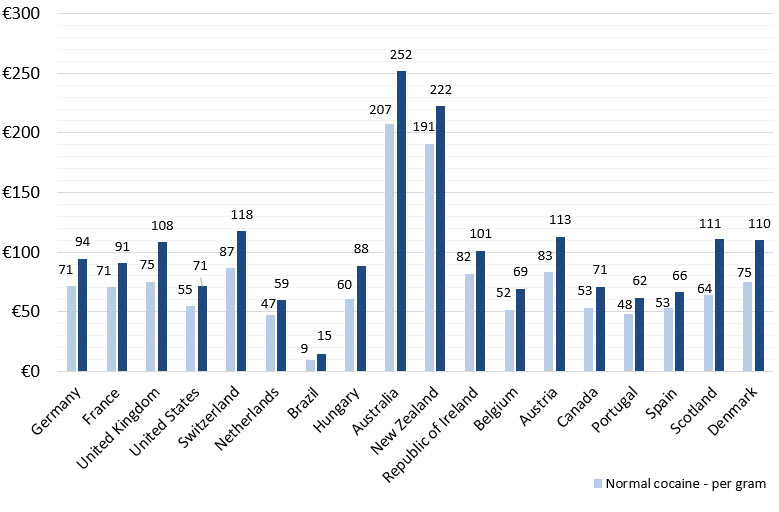
Potency and problems
But the Emergency Room and the Accident & Emergency Dept are not only the preserve of those taking new drugs and clearly on a population level and when considering the public health and economic costs, alcohol wins hands down. No surprise there but we were kind of shocked that 1% of last year cannabis users had sought EMT in the previous 12 months (compared to 1.2. % of drinkers). That’s a lot of people who are using a drug that we kind of think of as not that risky at least in the short term. Now while most reported feeling ‘back to normal’ within a day, overwhelmingly they’d smoked high potency weed – so once again potency ain’t always a good thing. Again we hope some guidelines might help
MDMA – sometimes bigger is not better
Now I know some people will give me a hard time if I keep on about the emergency room and acute drug problems, but we also saw a tripling in the number of last year MDMA users seeking EMT from 0.3% in GDS2013 to 0.6% in GDS2014 to 0.9 in GDS2015. Now although it’s important to note that GDS2013 was predominately UK, AU and USA whilst GDS2014 and GDS2015 involved much larger samples and more more countries, the trend is striking and worries me that better quality MDMA in pill or powder form, taken unwisely taken places people at greater risk of harm
A tripling in those seeking EMT is the last 12 months among ‘ecstasy users’
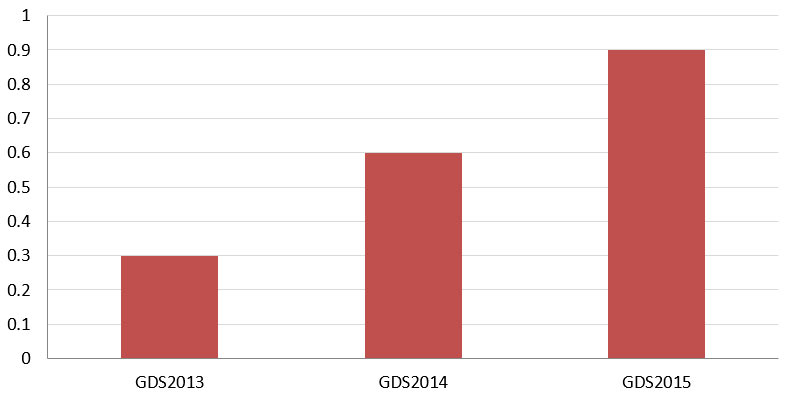
Don’t be making pills with 200mg + of MDMA in them please
Now although we saw a huge increase in participation rates and countries over those years you can escape the fact pills and MDMA crystal are about in abundance. Sometimes these pills contain in excess of 200mg and occasionally 300mg of MDMA, twice and three times what most people think is a reasonable dose. While the mean amount of MDMA consumed over a session seems to be about 1/4gm some countries are going way above that. No surprise that it is the UK topping the list at a whacking mean dose of 0.42mg/session (see slide below). I asked Vice’s Dutch editor Thijs Roes who had interviewed several pill producers what he thought was behind the production of these super dose pills. He told me: “What they’re doing is basically a pissing contest. One told me it was a competition between manufacturers and a race against themselves. The other described his 330mg pill as a flagship product, as a way to get known in the scene. They felt that users would know to dose them, and that the amount of MDMA would eventually stabilize around 200mg”. Our request would be make standard pills of 80-100mg and put the dosage on them – way more useful than logos for all concerned, and if you are knocking out 200mg pills put a big groove down the middle so people figure out they should just take half (or even better a quarter). Every time you get a new pill always take a quarter to start with and wait at least 60-90 minutes before dosing ‘start low go slow’
Amount of ecstasy (pills) and MDMA (grams) used per session
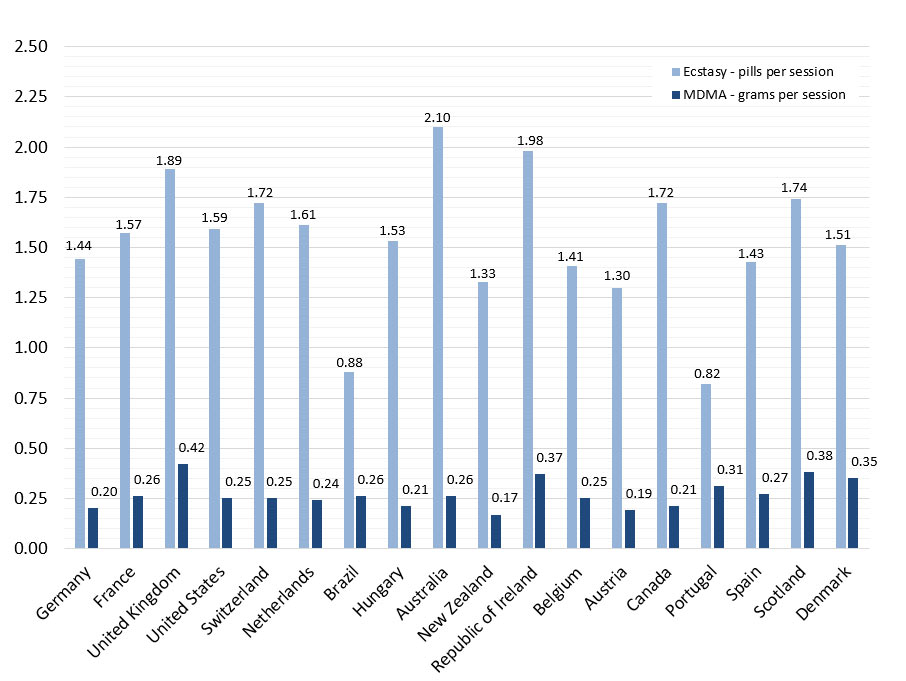
All of this combined with frequent consumption with alcohol and combining pills and powder explains the high rates of EMT we are seeing. What it says to me is that better quality drugs can cause more harm that rubbish ones – unless you know what your taking. Once again so many of these admissions could have been avoided with some common sense – see the GDS Highway Code for a safer use guide voted for by 80,000 people who use drugs at……. We’ll tell you more about just what the risk of seeking EMT is on MDMA and who is most risk at Club Health in Lisbon on June 17
Nitrous oxide / laughing gas
Some drugs sit in that grey area of legal versus not. Nitrous oxide is such a drug. And it remains true that a few balloons taken every now and then, somewhere safe and when you’re not already ‘munted‘ is not going to do you any harm but our data from almost 7000 last years users offers some words of caution. First thing is the big increase between GDS2014 and GDS2015 is people who reported being worried about the impact of nitrous oxide on their physical health – tripling from 2.5% to over 7.5%. Second is that nitrous oxide inactivates Vitamin B12. Lack of that vitamin – commonly in vegetarians can cause anaemia and nerve damage – called a peripheral neuropathy. Our findings last year suggested a strong dose response relationship between the amount you used in a session and frequency of use people reporting numbness and tingling persisting after use – a sign of peripheral neuropathy. This year with smarter questions developed with the help of a neurologist (thanks to Dr Paul Hart) our data seems to indicate even more clearly that somewhere in the region of 4% of last year users are reporting symptoms consistent with a peripheral neuropathy (numbness / tingling in face, arms, mouth, legs/shooting pains in limbs that persisted for weeks after last use). There was strong relationship with how much and how often people used. So if you use balloons, notice persistent numbness/tingling in your fingers/toes or around your mouth / face or notice you are off balance or are finding it hard to operate your phone – go see your doctor. Investigated and managed quickly the condition should be reversible. This is no laughing matter (the pun is intentional) and while we fear the media will come up with a headline like ‘hippy crack causes paralysis’ (thanks to Dr Stephen Kaar for that) we do just want to let people know that if you use a lot there are risks. You can avoid those risks by not using too much too often. I don’t think we need to regulate just educate… Our safer use advice is given below
Safer use tips from GDS to reduce the risks of using nitrous oxide.
- Don’t inhale directly from the charger
- Avoid mixing in nitrous when you are off your face on other drugs especially alcohol
- Try not to use more than 5 balloons in a session and leave time between them
- Make sure any space you are using is well ventilated
- Don’t use near roads, canals or other bodies of water
- Make sure you got mates around you in case you fall over and hurt yourself.
- Leave several minutes between rounds of hits and give yourself breaks between periods of use to refill those vitamin stores. Animal protein (beef and fish in particular), eggs, cheese are good sources of B12. Fortified soy products and supplements can be used by vegetarians. And Marmite!!!
- If you experience persistent numbness, tingling or weakness in your fingers, hands or feet, or notice you’re having difficulty typing or losing your balance or coordination strop using and go see your doctor.
- Finally there are reports that cheap whipped cream bulbs imported for China leave an oily residue when the gas evaporates – probably making them unfit to dispense cream let alone to inhale. So if you are going to inhale try accessing your gas from a quality supplier.
Prescription medication
We have so much data on prescription drug use it would take an update all if its own to share all the stuff we found. So as a cop out I will mention just 2 random things. First although the US is the biggest consumer and abuser of prescriptions opioids in the world – according to our cross-country comparisons (and there are significant limitations here) it looked like the US was the most difficult place to easily access a prescription for these drugs in the next 7 days. And unlike the rest of world where codeine (which is a highly respectable and effective opioid pain killer that gets turned into morphine in your body) is by far away the most common prescribed opioid – in the US it languishes beneath the potently profitable oxycontin and hydrocodone – where the US consumes 99% of the world’s production. The second thing is a request to my medical colleagues. Our study showed that less than 50% of patients in receipt of prescription opioids had ever been warned about the risks of addiction, so please have that conversation upfront when you stat prescribing. Informed patients are safer patients
The Dark Net
Our work on dark net markets is already some of the most cited in the world and working with leading researchers in the field like GDS’s own Dr Monica Barratt we’ve continued to tell the story of the biggest challenge to drug laws and their enforcement in a century. This year – just a few weeks after Ross Ulbricht got life without parole, we show that many of his claims and others that a decentralized drug market, away from streets and dark alley ways may have some truth. As our graph below shows shopping on line although not without risk certainly avoids many of the more dangerous aspects of face-to-face street level purchasing. And our findings show that year on year note and more people are shopping on the dark net (see graph below)
Comparing issues between dark net & alt source
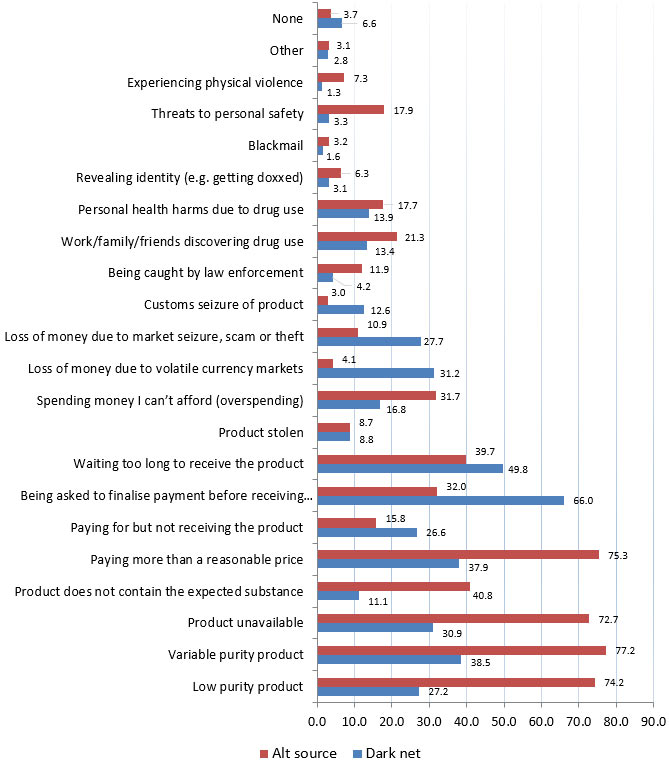
Reduced rates of exposure to violence, less adulterated drugs, more confidence in product quality and removal from street dealing were clear benefits. But as we suspected access to lots of drugs for some (it was a quarter of dark net market users) leads to experimentation with new drugs and extended drug repertoires which may not be a good thing for some people.
How has accessing drugs through darknet markets affected the range of drugs you have consumed?
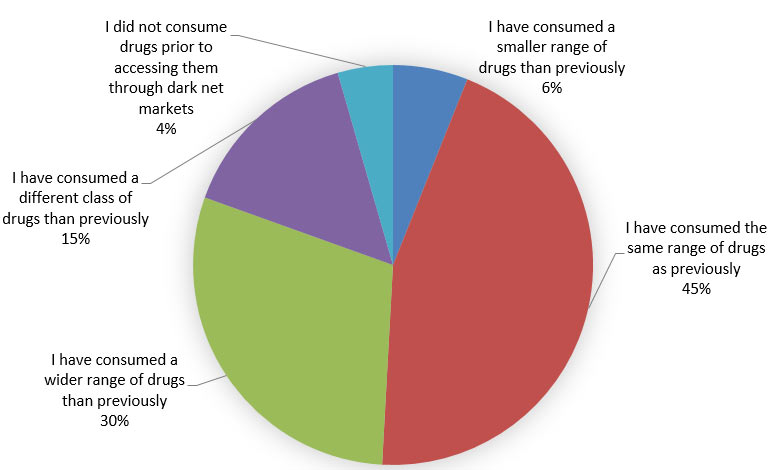
The fact that the biggest shoppers were from Scandinavia (where GDS did not have media partners so numbers were small) tells you something about how zero tolerance drug policies can drive people who like drugs toother sources
Have you ever bought drugs off the dark net* (%)
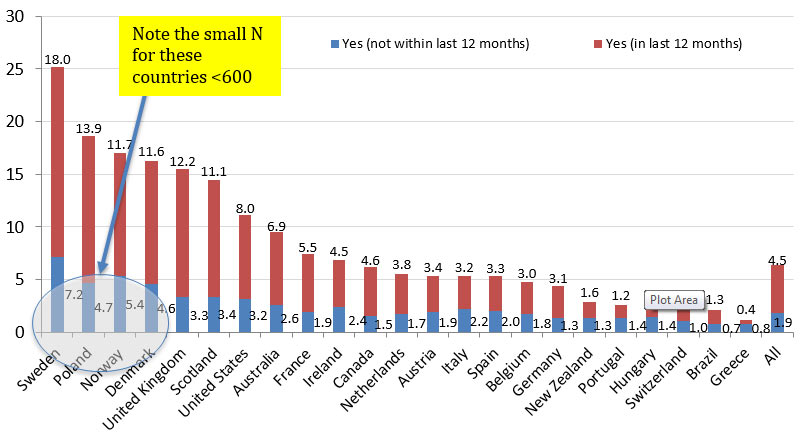
And that MDMA, cocaine, cannabis and LSD top the drugs bought on line support my assertion that ‘if you put most people on a desert island, and they have access to good quality cocaine, MDMA or cannabis, very few research chemicals would get a look in
Which drugs were bought through dark net? (%)
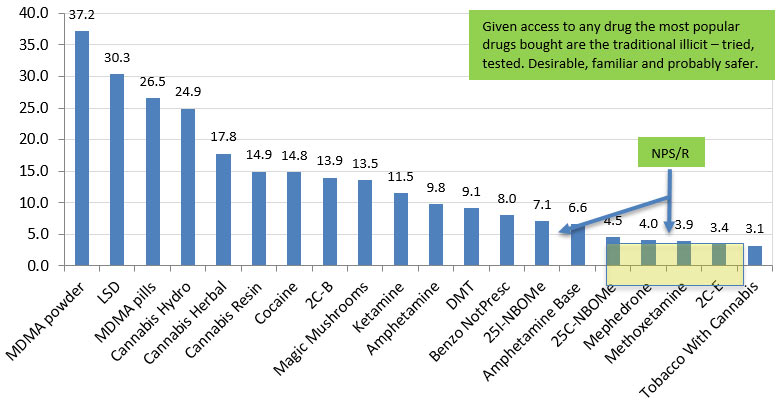
Proportion of recent drug users who report consuming drugs purchased through dark net markets in the last 12 months
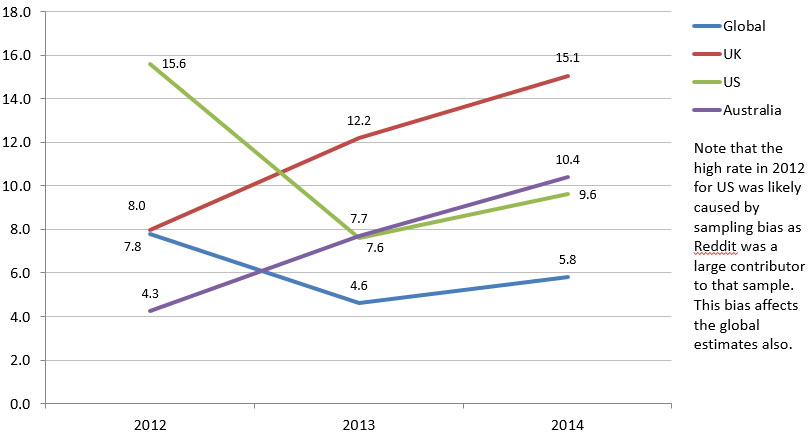
Four year GDS UK trends in recent internet drug purchase and NPS/RC/LH use
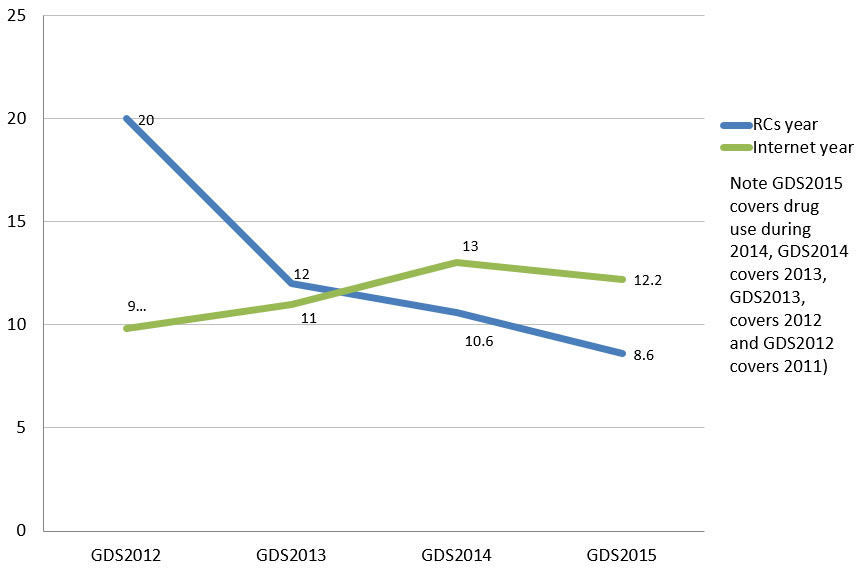
Cognitive enhancers
For the first time this year we partnered with a cognitive enhancer expert Dr Larissa Maier. We found that one in 10 “healthy” (no diagnosis of ADHD) study participants (9.8%) had ever used prescription or illegal stimulants to improve performance at work or while studying. However, only half of them or 4.9% of “healthy” study participants reported using drugs for cognitive enhancement during the past 12 months. Pharmacological cognitive enhancement was more prevalent among participants with a self-reported attention-deficit/hyperactivity disorder (ADD/ADHD); one third (30.2%) reported cognitive enhancement use during the past 12 months. Participants from New Zealand, the Netherlands, and Hungary were the most experienced with cognitive enhancement (15.2% to 18.2%), while the rate of experienced U.S. participants was only slightly above the average (11.6%). Methylphenidate, illegal stimulants, and dexamphetamine were the substances most commonly used for enhancement. Most participants reported the use two to 10 times in the past 12 months, primarily during exam periods or stressful periods at work (43.6%). Daily stimulant use for cognitive enhancement use was uncommon, but one third of people who most commonly used illegal stimulants for enhancement reported at least weekly use for cognitive enhancement. For the most part, users reported that pharmacological cognitive enhancement was what they expected or even better. Nevertheless, one fifth of methylphenidate users and one in 10 dexamphetamine users were not satisfied with the effects of the drug regarding cognitive enhancement. Finally, one third of cognitive enhancement users would like to use less next year, but less than 5% would like to seek help
In case you want to know what GDS2016 – launching in Nov 2015 will focus on we’ll tell you now
- Psychedelics – we’ve partnered with the world’s leading experts to run the biggest study in how and why people use these fascinating drugs
- Cannabis as medicine
- How vaping is changing the way we use drugs
- How why you use drugs can predict if you’ll run into problems
- Drug tourism
- How putting drug laws up for review / revision would alter people’s voting patterns at their next election.
If you want to help us / partner with us / donate to us please contact
So thanks for now
Have a safe summer
Adios
Adam Winstock
Founder and Director Global Drug Survey
Big /huge/thanks to
Dr Jason Ferris
Dr Monica Barratt
Dr Larissa Maier
Special thanks to
Jon Waldron
Dr Stephen Kaar
Professor Micheal Lynskey
Professor Mark Bellis
Professor Karyn Hughes
Kathryn Ashton
Dr Martin Chandler
David Crane
Dr Mike Shiner
Dr Elaine Mosman
Chris Parsons
Katherine Berry
Claire Dean
The boys at DTC
INPUD
And all the network of clever/passionate academics in every country and all their teams
